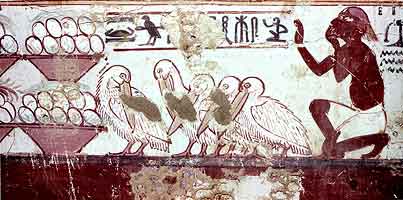|
||||||||||||||||
|
|
||||||||||||||||
|

Humans, Nature and Birds |
From Room 2: Birds as Resources for Human Use |
||||
|
|||||
 Plate 12 |
Egyptians domesticated them for the same purpose that Japanese fishermen traditionally used Japanese Cormorants (Phalacrocorax capillatus), fitted with a restrictive collar, to catch fish. In fact, a pelican, a fish-clutching cormorant, and a group of fishermen hauling laden nets are included in an ancient Egyptian bas-relief (the mastaba of Mereruka), which was produced during the Sixth Dynasty (2345–2181 BCE), 1,000 years before Horemheb. In the bas-relief, neither bird has a collar, so perhaps fishermen merely watched them during foraging dives to see where to cast their nets. On the other hand, the baskets in this painting contain a lot of eggs, suggesting that they were a delicacy suitable for a pharaoh. Few pelicans are represented in Egyptian art, perhaps because they were more often admired and raised by commoners, thus keeping them off the walls of nobles’ tombs. Why, then, are they here? Horemheb--unlike most Egyptian kings--was not of royal blood. Perhaps the pelicans are present as a special recognition of his history. Ancient Science Art provides abundant room for speculation, but in the end it often leaves a mystery-- in this case, one that perhaps future Egyptologists will solve. Some might see speculation as an inherent weakness of Science Art. We see it as an invitation to delve deeper into both the image and page 4--> |
||||
|
|||||